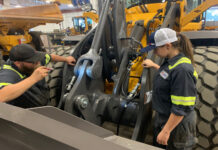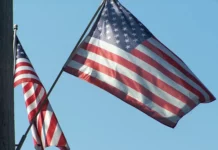Dave Sanders is the Director of Safety and Risk for Ruppert Landscape, headquartered in Laytonsville, MD. In his role, Sanders is responsible for the safety of Ruppert’s 1,900+ employees in 30 branches across the U.S. Turf asked him to share his insights on strategies Ruppert utilizes to minimize risks and accidents.
What are the biggest safety challenges currently facing landscape workers? Are there regional differences in risks?
While every company faces their own unique challenges, one of the universal challenges facing our industry is the labor shortage. While this may seem like just a labor issue, it has the potential to be a safety issue as well. If a crew is working a person short, they may be tempted to work faster or take shortcuts—both of which can increase the chance of a safety incident. Keeping employees focused on doing the job the right way, preparing the crew by training them effectively, sharing the goals and plans for each day’s work, and taking a moment to think before performing each task are the most effective ways to address the safety challenges we face every day.
The regional differences that we face primarily come from weather and climate differences. Our northern regions deal with snow, ice, and cold temps through the Winter while our southern branches have a longer growing season and can have extended extreme heat in the Summer.

In this tight employee market, how does the amount of new hires affect safety policies/risks?
We are committed to making sure that all our new team members have the tools, skills, and knowledge they need to be successful and safe. This starts on day one with the idea that safety is everyone’s responsibility and that we must all work together to ensure that the workplace and our jobsites offer a safe environment for our people and our customers. Within the first 10 days of being hired, all new employees complete a series of onboarding videos to orient them to the company, which includes a safety component. Additionally, all new hires have specific training prior to the task they’re being asked to complete. This means some one-on-one training with tools and equipment, including that new employees demonstrate their proficiency with what they’ve just been shown.
Industry statistics have shown us that newer workers, who have been employed for less than three months, are three times as likely to be injured on the job. Several years ago, we implemented a way to help our front-line teams readily identify newer team members by having them wear a safety vest with an orange stripe for the first 90 days. This enables greater focus on teaching and coaching and ensures that the new person receives that extra attention and foundation they’ll need to be successful in our industry. Every new employee is also assigned a safety mentor who knows policies and procedures and demonstrates good safety behaviors to ensure the new employee is trained properly.
How do you create a “culture of safety?”
Safety is everyone’s responsibility and is dependent on each person doing their part— from our executive team and safety director to our most tenured field manager and our very newest crew member. It’s the collective effort and focus of doing it the right way whether someone is watching or not.
Building culture starts with senior management setting the tone and communicating about the safety program and providing support and direction along the way. The real foundation for the success of our safety program is our front-line super- vision team–our field managers. They are the ones with an eye on daily operations, which allows them to observe, analyze, and influence. Ultimately, they have a more direct impact on employee behavior and dictate the direction of our safety culture by ensuring policies and procedures are followed, PPE is in place, and safety behaviors are practiced. The final piece of the puzzle is every employee, working hard every day and taking responsibility for their own safety— and that of their co-workers. That means not taking shortcuts, staying focused, taking faulty equipment out of service, being aware of hazards and surroundings, driving defensively, always wearing PPE, and pointing out any unsafe behaviors of team members.
Specifically, what kind of safety training do you employ and how is it done?
As mentioned, safety training starts the very first day on the job with our onboarding and orientation process. Information is shared in many ways: via video, in person, in written form, and in both Spanish and English to ensure that all employees receive the information in a way that suits their needs. Employees are provided training on equipment and tools they will be using, tasks they will be performing, and hazards they may encounter. Additional training, dictated by position and division, includes first aid courses, OSHA training, defensive driver training, flagger certification, and work zone safety to name a few. Branches begin their day with a morning stretch and flex to promote balance and flexibility. That’s followed by a morning huddle which affords an opportunity to start the day with a positive safety message, talk about branch specific safety statistics, review current hazards or incidents, and demonstrate a safety technique. These practices help to set the tone for the day and provide a daily pre-scheduled opportunity to share information and reinforce our safety mindset.
As the company has grown—we are now at 30 branches—it has become even more critical that everyone is receiving the same training and safety messages. We addressed that challenge by having a Safety Representative in each branch, who make up our larger Safety Committee, led by our Director of Safety and Risk. These employees help with inspections, reporting, documenting, and training—as well as making sure the branch teams have all the tools, equipment, and knowledge they need to work safely and efficiently. The Safety Committee holds bi-weekly conference calls to review safety performance, incidents, near misses, and best practices. In quarterly meetings, then, the Safety Committee also: performs more involved analysis of incidents; reviews and creates policies and procedures; meets with our insurance carriers; and refines safety training.
How important are inspections? Timely reporting? Signage? Written policies?
We build safety practices and principles into our everyday routines, hold ourselves accountable, and measure how we’re doing so that we can adjust and improve. Well-communicated written policies and well-documented procedures provide the framework for a strong safety culture, providing information and ensuring responsibility and accountability. The concept “inspect what you expect” is an idea that resonated with us. We perform job hazard analyses to minimize hazards and reinforce site-specific safety practices, inspect and monitor our crews for safety compliance and knowledge, and routinely monitor our vehicles and equipment for safety issues.
When any safety related incident occurs, it’s reported immediately to a supervisor to ensure that injuries receive the best care, additional risk to anyone else is minimized, and the details of what happened are accurately captured. We track information to ensure OSHA compliance and generate weekly incident emails that are shared with the company’s executive team to keep them apprised of what’s happening. Addition- ally, incident charts and ratings are shared monthly at our financial meeting and at the branch level as well, helping to ensure everyone is accountable and “in the know” about which branches are compliant and which branches are having challenges.





In addition to benchmarking ourselves year-over-year and against other branches within our organization, we also work hard to ensure that our Experience Modification Rating (EMR) remains under a score of 1.0. This rating, much like a credit score, is tallied by a third party who considers the company’s cost of past injuries and future chances of risk and is a good indicator of a company’s overall safety. Companies with scores below 1.0 are considered safer than most and it’s a deter- mining factor in our ability to bid certain projects, which is why we closely monitor and safeguard this rating.
Do you see any emerging safety issues?
Although not a new phenomenon, one of the most commonly occurring and ever-increasing safety issues that we see is distracted driving. (See “Cutting Down Distracted Driving.”) Whether it’s texting, calling, emailing, eating, changing the radio station, or any other action that takes a driver’s eyes off the road or hands off the steering wheel, distracted driving is very dangerous and is becoming more and more prevalent. With distracted driving injuries and fatalities on the rise (according to NHTSA as of April 2020, 15% of all injury crashes and 8% of all fatal crashes are a result of distracted driving), we instituted a distracted driving policy that bans the use of cell phones (handheld or hands free) while operating a Ruppert vehicle or using a company-issued cell phone in a personal vehicle. All drivers are expected to put away or silence their phone while driving, with a progressive disciplinary plan in place for those that violate the policy. As a means of monitoring this and providing us with the ability to coach and mentor, we installed dash cams in all our production vehicles, which record 12 seconds before and after an “event” (bump, sudden stop, collision, etc.) The goal here is not to act as “big brother,” but to change behavior using timely coaching to correct unsafe driving behaviors. The dash cam footage also helps us properly investigate accidents, address the root cause, and pro- vide additional training to ensure it doesn’t happen again.
How did Ruppert’s partnership with Dr. Blink come to be? What are the benefits?
When an on-the-job injury occurs, our priority is making sure that our injured employee receives the best possible care. That means consulting medical experts to help evaluate what happened and determine the level of care needed immediately for our employee. For almost a decade, we’ve been partnering with Dr. Robert Blink and Worksite Partners Medical Group to be our on-call 24/7 resource for any work-related injury. The relationship began with a recommendation from our broker who suggested the doctor and his group might be a good partner to assist us with reducing injuries by ensuring an appropriate level of care.
If an injury is life-threatening, dialing 911 is the best option for quick and qualified care. But when that’s not the case, the supervisor, with the injured worker present, calls the 24/7 injury hotline. They speak first with an operator who rules out that it’s not necessary to call 911, then gets some of the initial details about the injury and what happened before connecting that team member with Dr. Blink. Dr. Blink, who is bilingual, then speaks directly with the employee about what happened, how s/he is feeling, and they work together to determine what the next steps should be. This resource helps to determine the most appropriate care, which might range from going to the closest emergency room, to scheduling an appointment with a specialist or family doctor, to administering self-care or first aid treatment without seeing a medical professional. In the end, the decision is made by the employee.
This is a tremendous resource for employees who have had an injury or may just have a medical question. It provides our employees with access to someone on the spot who can help with a decision as to what the best and most convenient treatment should be. In many instances, it can prevent unnecessary visits to the emergency room and can help guide an employee to the best possible care choice.
Sanders has been with Ruppert Landscape for over 13 years and has over 40 years of experience in the green industry in both safety and operations management. For more information on Ruppert, visit ruppertlandscape.com.
Do you have a comment? Share your thoughts in the Comments section below, or send an e-mail to the Editor at cmenapace@groupc.com.











![[VIDEO] Dickies®: Discover Workwear That’s Anything But Uniform](https://turfmagazine.com/wp-content/uploads/2023/06/1647663814-4b1a2a7742790a9b1e97a3b963477850192e1d6a9dfba9b07214a77bae25d6e3-d-218x150.jpg)




























![[VIDEO] Dickies®: Discover Workwear That’s Anything But Uniform](https://turfmagazine.com/wp-content/uploads/2023/06/1647663814-4b1a2a7742790a9b1e97a3b963477850192e1d6a9dfba9b07214a77bae25d6e3-d-324x160.jpg)